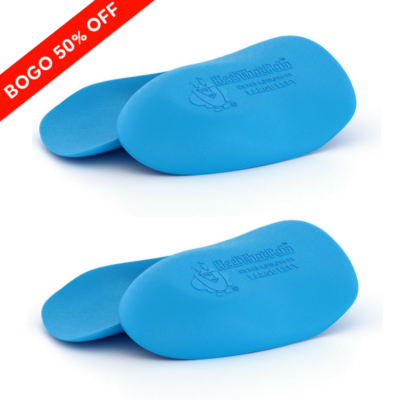Nerve Entrapment and Heel Pain
Heel pain is one of the most common foot problems podiatrists encounter. Typically, the culprit is plantar fasciitis – a condition caused by inflammation of the plantar fascia. However, several less-common conditions cause heel pain and masquerade as plantar fasciitis.
Heel pain that presents as plantar fasciitis, but does not respond to treatment, may be plantar nerve entrapment. High impact activities like running or ballet, which involve repetitive motions and significant stress to the arch and heel, are the primary cause. Researchers have found that individuals with flat feet are particularly prone to nerve entrapment, since the arch is less effective in absorbing and distributing impact.
Nerves at risk for entrapment include the main plantar nerve, also known as the calcaneal nerve, as well as the medial plantar nerve (which runs along the inside, central part of the arch) and lateral plantar nerve (which runs along the outside, central part of the arch).

Symptoms of Plantar Nerve Entrapment
Unlike plantar fasciitis, the hallmark of plantar or calcaneal nerve entrapment is constant, chronic pain–even when resting and without weight bearing. Other symptoms of plantar nerve entrapment include the following:
- A burning sensation on the underside of the heel
- Tenderness and pain to the touch where the nerve is entrapped
- Pain that is worse at night in contrast to the pain from plantar fasciitis that is typically worse in the morning
- Pain that gets worse with stretching, in contrast to plantar fasciitis which responds positively to stretching
- Severe pain from standing and physical activity
Causes of Nerve Entrapment and Heel Pain
Plantar or calcaneal nerve entrapment is most common among people who overpronate while walking or running. People who participate in high impact sports with repetitive motions are also at risk. Ill-fitting shoes are another culprit, and can cause the nerve to become entrapped. Repetitive motion combined with high impact is a particular risk factor for nerve entrapment, since these motions can lead to inflammation, trauma, and swelling over time, while the high impact activities can compress and impact the lateral or medial calcaneal nerves.
Diagnosis of Nerve Entrapment in the Foot
Doctors often use a simple test to differentiate nerve entrapment from plantar fasciitis. If an anesthetic applied to the most tender area of the heel relieves symptoms for a few hours, it’s likely that you are dealing with a case of nerve entrapment rather than plantar fasciitis. Your doctor may also stretch and put mild pressure on different points of your foot and heel, since the way your toes and foot respond can reveal whether nerve entrapment has occurred.
Treatment and Prevention of Plantar Nerve Entrapment
In order to treat the heel pain caused by nerve entrapment, you must relieve the pressure on the nerve. In mild cases, switching to more supportive, correctly fitting shoes can help. However, in many cases, specialized padding and support are needed in the form of orthotics. Orthotics with Fascia-Bar Technology lift the heel and provide cushioning, alleviating pressure on the trapped nerve while providing relief to the tender heel.
Immobilizing the foot for a period of time is also important for the healing process. While rest may not reduce pain, it will decrease pressure and strain on the nerve, as well as calming inflammation. Your doctor will also likely recommend the use of anti-inflammatory medication, like ibuprofen, to help with inflammation
In rare severe or complicated cases of nerve entrapment, cortisone injections or surgical decompression may be needed.
Have more questions about plantar fasciitis or nerve entrapment? We’re always here to help!
Send us an email, or give us a call at 877-215-3200.






